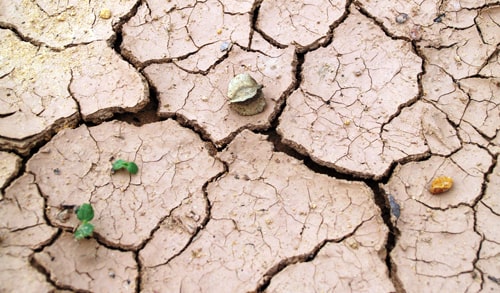
California has been facing a severe drought crisis for several years now. The absence of precipitation and insufficient snow accumulation has resulted in the depletion of water reserves, causing stress on California's agricultural industry and jeopardizing the water supply for millions. In this article, we'll examine the underlying reasons, impacts, and viable remedies for this persistent issue.
It is important to remember that this is a long-term problem and that it requires long-term solutions. We can not wait for another rainy season to come and solve the problem, we must act now and be proactive in our water usage. It's time to change our habits and make water conservation a part of our daily lives.
Causes of the Drought Crisis
The drought crisis in California is a complex issue that has been caused by a variety of factors. Climate change has played a significant role, as it has caused a decrease in precipitation and snowpack in the region. Population growth has also had an impact, as more people require water for daily use.
Additionally, water management policies and infrastructure have not kept up with the changing needs of the state, leading to the over-allocation of water rights and outdated systems that are not equipped to handle the current drought conditions. All of these factors have contributed to the ongoing water crisis in California.
|
Consequences of the drought crisis
The consequences of the drought crisis in California are far-reaching and significant. The agricultural sector, which relies heavily on water for irrigation, has been hit hard by the drought. Due to the lack of water caused by the drought, numerous farmers have been forced to either leave their fields uncultivated or use costly methods like drilling deeper wells or buying water from alternative sources.
The drought has also impacted the state's energy sector, with reduced hydropower production and increased reliance on fossil fuels. Additionally, the drought has had an adverse impact on the state's natural ecosystems, including fish and wildlife habitats, as well as the tourism industry, which relies on California's natural beauty to attract visitors.
|
Potential solutions for the drought crisis
There is no single solution to California's drought crisis, as it is a complex and multifaceted issue. However, several potential solutions have been proposed and are currently being implemented in the state. Several solutions have been proposed to address the drought crisis in California. These include water conservation measures, water recycling and reuse, and investment in new technologies.
Water conservation
Water conservation is a critical aspect of addressing California's water crisis. It involves reducing water usage in all sectors, including agriculture, industry, and households. The state has implemented several water conservation measures, including mandating water-efficient plumbing fixtures, incentivizing the use of drought-resistant landscaping, and promoting the use of low-flow irrigation systems.
Additionally, households can contribute to water conservation by adopting simple practices such as taking shorter showers, fixing leaky faucets and pipes, and using a broom instead of a hose to clean outdoor spaces.
|
Water recycling and reuse
Another solution to the drought crisis is water recycling and reuse. The state has implemented several programs to promote the use of recycled water for irrigation and industrial purposes. Recycled water can also be used for non-potable purposes such as flushing toilets and washing clothes. This helps reduce the demand for freshwater, which can then be used for drinking purposes.
|
Desalination
Desalination is the process of removing salt and other minerals from seawater to produce freshwater. California has several desalination plants, with more currently under construction. Desalination can be a costly process, but as technology advances, the cost is decreasing, making it a more viable solution to the state's water crisis.
|
Stormwater capture
Stormwater capture involves capturing and storing rainwater and using it for various purposes. California has implemented several programs to promote the use of stormwater capture, including providing incentives for homeowners to install rain barrels and promoting the use of green infrastructure such as bioswales and rain gardens.
|
Changes to water management policies
Changes to water management policies are necessary to address California's water crisis fully. The state's current water management system is outdated and inadequate to handle the changing needs of the state. The system is also complicated and fragmented, with numerous agencies responsible for managing water resources.
|
Innovative technologies
Drought is a serious problem affecting many parts of the world, including California. Fortunately, there are innovative technologies that can help alleviate the impacts of drought.
-
Water recycling and reuse:
Recycling and reusing water is becoming increasingly popular in drought-prone regions. Technologies such as reverse osmosis and advanced filtration systems can purify wastewater for use in irrigation or other non-potable applications.
-
Drought-resistant crops:
Scientists are developing new crop varieties that are better adapted to drought conditions. These crops can survive on less water than traditional varieties, making them ideal for regions with limited water resources.
-
Precision agriculture:
Precision agriculture uses sensors and other advanced technologies to precisely control the application of water and fertilizers. This ensures that crops receive the exact amount of resources they need, reducing waste and improving yields.
-
Soil moisture sensors:
Soil moisture sensors are placed in fields to measure the amount of moisture in the soil. This information is used to optimize irrigation schedules and prevent overwatering, which can lead to water waste and environmental damage.
-
Cloud seeding:
Cloud seeding is a process where chemicals are introduced into clouds to encourage rainfall. While this technology is still experimental and controversial, it has the potential to increase rainfall in drought-prone regions.
-
WaterAid Drought Solution:
WaterAid Drought Solution is a non-toxic liquid concentrate designed to help retain water in lawns, gardens, and plants, reducing water usage by up to 40%. This innovative product is designed to decompose naturally over time, and it helps reduce water infiltration by retaining water at the root level for a longer period of time. Successful field tests have shown the effectiveness of WaterAid Drought Solution in addressing water scarcity and promoting sustainability.
|
Conclusion
The drought crisis in California is a complex and ongoing problem with significant consequences for the state's economy, environment, and society. Addressing this crisis will require a combination of solutions, including water conservation measures, investment in new technologies, and changes to water management policies.
WaterAid Drought Solution offers a promising solution to this problem, allowing homeowners and businesses to conserve water without sacrificing the health and beauty of their lawns, gardens, and plants. It is time for all Californians to come together to find sustainable solutions to this pressing problem and ensure a better future for our state and planet.
|
|
|





